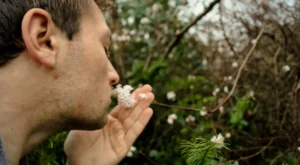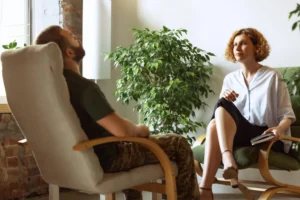We offer medical detox and multiple addiction treatment options in our
luxury treatment centres in Port Hope, Cobourg, and Ottawa.
The Cycle of Addiction
Addiction is a complex illness that causes lasting changes in brain chemistry and functioning. These changes do not only make a person crave their addiction, they can lead to emotional, psychological, and physiological dependence, affecting every aspect of a person’s life. Addicts find that they’re trapped in a complex cycle of addiction from which breaking out seems impossible.
Recognizing and understanding the cycle of addiction is a fundamental step on the road to complete recovery. Typically, the addiction cycle involves periods of heavy substance use, separated by periods of self-imposed clean living, which can give a person the impression that they can quit the addiction by deciding not to use anymore. This thinking is deceptive because following any period of sobriety, if a person starts to use substances again, the addiction gets reactivated in the brain, and the cycle of addiction starts all over.
Most addicts are oblivious to the cycle they’re trapped in and may not see the need to seek help. This cycle will continue unhindered until there is some professional intervention. This guide explains the addiction cycle and the stages of breaking the cycle.
Key Takeaways
- Addiction causes changes in brain chemistry that make a person unable to stop using a substance even when it has obvious harmful consequences
- A person trapped in the cycle of addiction, and if not active in the process of recovery, may go through periods of emotional restlessness that will lead to a relapse.
- Until the cycle of addiction is broken, the periods of self-imposed sobriety are equally part of the cycle as the times of heavy substance use.
- Professional addiction treatment is required to break out of the addiction cycle completely.
What is the Cycle of Addiction?
An addicted brain is functionally different from a normal one. To understand the cycle of addiction, it’s important to see addiction as a neurological condition, not the result of weakness or moral failure. Anyone with a recurrent substance abuse problem is in the cycle of addiction. A person trapped in this cycle will use their substance of choice as usual, and by external influences or willpower, they will stop using and begin a period of self-imposed sobriety.
This period of clean living could last weeks, months, and even years before a feeling or event triggers the cravings, causing the person to start using again. Feeling guilty and remorseful, the person tries to live sober for a while before something triggers them to use again, and the cycle continues.
The substance abuse cycle generally includes the following processes:
- Frustration, pain, or anxiety and a demand for relief of these symptoms:
- Craving for the substance of choice for symptom relief
- Fixation on using the substance of choice and fantasizing about the effects of the addiction
- Using the substance or engaging in an addictive activity.
- Losing control over the addictive behavior
- Feeling remorseful, ashamed, or guilty over the behavior
- Feelings of dissatisfaction that lead to a promise or resolve not to use again or engage in the behavior.
- Frustration, pain, and anxiety return after a period of clean living, causing a demand for symptom relief.
The length of the cycle varies among addicts, and it’s difficult to break out of the addiction cycle without help. A binge user can go through the stages of the cycle several times a day, while others can take years to complete one cycle. An external intervention or the addiction’s consequences (financial, legal, social, medical) can disrupt the cycle at any point.
If you or a loved one is caught in the addiction cycle, it’s important to get professional help immediately. Call 1-855-499-9446 now and get the help you or your loved one needs or request a call, and we will take care of the rest.
Addiction Explained
Addiction is a chronic brain disorder that leads a person to lose control over how they use a substance or engage in an activity. An addicted person will crave and seek drugs and alcohol or continuously engage in activities like sex, eating, and gambling despite obvious adverse consequences.
Understanding drug abuse and addiction are necessary for successful management. Drug abuse is the use of an illegal substance or the improper use of a legal substance. A person can engage in drug abuse without being necessarily addicted, but continuous substance abuse will inevitably lead to an addiction.
It’s important to note that addiction is a disease and not necessarily due to moral failure. Addictive substances or activities cause an intense, enjoyable feeling, creating a powerful urge to experience those feelings again. Addictive substances rewire the brain to think it needs them for normal functioning, making the user unable to stop.
Addiction often starts as a social experiment that gets out of control. A first-time user feels intense pleasure after using the substance or engaging in the activity and wants the experience again. Addictive substances flood the brain with dopamine, a feel-good chemical that rewards and motivates one to repeat the behavior. Continued exposure to the behavior leads to tolerance, where larger amounts of the substance are required for the same effects.
If the behavior continues, the brain starts to depend on the substance for normal functioning, and withdrawal symptoms occur if the user stops using the substance. At this point, the person is considered an addict. Addiction usually takes time, but a person can become hooked on the most addictive drugs with one try.
Addiction is a complex condition and usually difficult to treat, but professional intervention and the right support can help a person completely break out of addiction:
Signs of a Drug and Alcohol Addiction
Not all signs of addiction are observable, and addicts typically go to great lengths to conceal their addiction. The most obvious signs of a drug addiction to watch out for include:
Behavioral signs
- Obsessive thoughts of the drug and accompanying reckless actions to obtain it
- Loss of control even when the person tries to stop using the drug
- Denial of addiction or concealing drug use
Physical signs
- Bloodshot eyes
- Enlarged or smaller pupils
- Sudden weight gain or loss
- Slurred or uncoordinated speech
- Poor hygiene and an unkempt appearance
- Poor physical coordination
- Insomnia or oversleeping
Emotional signs
- Irritability
- Loss of interest in family, friends, and activities
- Confusion and disorientation
- Justifications and rationalization for drug use
If you observe a couple of these signs in a loved one, they may be hiding an addiction, and you may need to encourage them to seek help.
Drug and Alcohol Addiction Effects on the Brain
The brain is connected by millions of nerve cells (neurons) that control feelings, movement, and bodily sensations. Nerve cell action is regulated by neurotransmitters, chemical messengers that carry and balance signals throughout the brain. Dopamine is a neurotransmitter that regulates the brain’s reward and impulse control system.
The brain’s dopamine balance is altered when a person uses drugs or alcohol. Drugs over-stimulate dopamine receptors causing a release (euphoria) or a lull (sedation). The desire for these sensations causes the individual to crave more of the drug or alcohol, which will lead to tolerance, dependence, and addiction.
The brain adapts to consistent alcohol or drug use and becomes reliant on it, leading to impulsive and often risky behavior to obtain the substance of choice. At this point, the user is no longer in control of their actions and will continue to fight overwhelming urges with little to no success. This is why it’s crucial to tackle addiction as a disease that requires professional intervention. Once a person is trapped in the cycle of addiction, the power to choose by self-will alone is lost.
The 6 Stages of the Cycle of Addiction
Six stages make up the cycle of addiction:
Initial use
Addiction always starts with the first use of the substance. A person may try an addictive substance for several reasons, including peer pressure, boredom, curiosity, stress, or performance enhancement. It could also be a prescription for a mental health issue or pain. The initial use of a substance is often not enough to trigger addiction, but other risk factors like depression, trauma, abuse, and genetics may play a role in addiction.
The pleasure from initial use is powerful and can drive a person to continue using the substance. This is the first step towards addiction that leads to the next.
Abuse
The second stage of the addiction cycle is when the person starts to use the substance on a frequently improper basis. Abuse could involve taking more than the prescribed doses of a painkiller or regular binge drinking. The initial use of hard drugs like cocaine or methamphetamines qualifies as abuse. At this stage, the user takes the substance not for social acceptance or to treat a condition but for its pleasurable effects. With continued abuse, the individual will need higher doses of the drug to get the same effect.
Tolerance
The third stage occurs after drug abuse has gone on for a while. Tolerance occurs due to brain changes that make the initial dose of the drug unable to produce the same effect. The addict will require higher doses of the drug to get the same amount of pleasure. They may also switch to a more potent drug or increase the frequency at which they use it.
These changes will work for a while until the brain becomes tolerant to the new dosage, forcing the person to increase the dosage again. At this stage, the individual will progress to heavy substance use, leading to the next stage.
Dependence
In the fourth stage, the individual does not only need the substance or the activity for pleasure; they need it for normal functioning. Dependence brings on extremely negative feelings without the substance or activity of choice. The cravings are more intense at this stage, and the individual will go to great lengths to sate those cravings. They may experience withdrawal symptoms at this stage, depending on the drug.
Dependent addicts tend to use more of the drug to escape these symptoms, inadvertently pushing them further into the addiction cycle. Not all drug dependence is considered addiction; a person may be dependent on a drug for medical reasons.
Addiction
Addiction happens when the individual cannot go without using their substance of choice or engaging in the activity. They feel trapped in their situation and experience problems in their lives due to the situation. People at this stage could lose their jobs, relationships, home, or health and still be unable to quit. At this point, the only way out for the individual is to seek professional addiction treatment.
Relapse
Relapse is the final stage in the addiction cycle. Typically, a crisis moment brings some clarity and a resolve not to use the substance again. A period of abstinence follows until the individual encounters a trigger, and a craving for the substance overwhelms them. Addicts trying to quit without help will eventually lose control and fall back to substance use. Relapse often returns addicts to dependence, the stage that prevents most addicts from breaking out of the cycle.
The 5 Stages of Breaking the Cycle of Addiction
Researchers studying how changes occur in people who overcome addiction developed a “transtheoretical” model to describe how people break out of addictions. The five stages of breaking the cycle of addiction are:
Precontemplation Stage
A person in the precontemplation stage does not consider their addiction a problem and will not see the need for help. They enjoy the pleasure of their addiction and are yet to have a significant negative experience. This stage is also marked by defensiveness and justification of addictive behavior. Some people remain in this phase because they don’t have sufficient information about addictive behavior. The frustration from several failed attempts at quitting can also make a person believe recovery is impossible, keeping them stuck in this stage.
Contemplation Stage
The contemplation stage is characterized by a readiness to change sometime in the future but not immediately. A person in the contemplation stage understands the benefits of living drug-free, but they still enjoy the pleasure their addiction brings. They are open to learning more about their addiction but will not commit to getting clean. Addicts can stay in contemplation for years without moving to the next stage. You can guide a person from this stage to the next by offering non-judgmental information and encouragement.
Preparation Stage
A person in the preparation stage is mentally ready for change and may be taking steps toward getting help. They may join a gym, speak with a therapist, obtain the required resources, and abstain from the addiction for a few days. However, difficult emotions or triggers can push people from the preparation stage back to the contemplation stage.
Action Stage
The action stage is characterized by concrete steps toward overcoming addiction. Real change starts here as the person begins to modify their behavior and seek professional help. There will be long periods of abstinence and a willingness to continue the process if there’s a relapse. The individual identifies their triggers and makes plans to avoid them. The action stage also leads to improved self-awareness and self-care. An addict in this stage needs counseling and support to help them move to the next.
Maintenance Stage
A person in the final stage of breaking the addiction cycle is fully committed to preventing relapse; they keep up with counseling appointments, lifestyle changes, and support meetings. The urge to relapse is not as strong in this stage, and the individual grows confident in their ability to beat the addiction.
This stage can last between six months to five years, depending on genetic factors and the severity of the addiction. It’s possible to become complacent in the maintenance stage after a while due to reduced focus and the pressures of life. Addicts must learn new ways of coping with stress in this stage to genuinely solidify change and beat the addiction.
5 Tips for Breaking the Cycle of Addiction
Breaking the addiction cycle can seem daunting and even impossible, especially for people who have tried multiple times unsuccessfully. Addiction causes people to feel isolated and alone, leaving them unable to find a way out. However, with appropriate guidance and the right amount of commitment, anyone can overcome addiction. Here are five tips for breaking the cycle of addiction:
Recognize the Problem
The first thing you want to do is to recognize that addiction is a disease that requires decisive action. Many people cannot break out of the addiction cycle due to denial or justification of the problem. If your loved one is trapped in the addiction cycle, the first thing is to help them see that they have a problem.
Identify Your Day-to-Day Habits
The addiction cycle is often set in motion by triggers that you can identify by examining your daily habits. Triggers could be stress, an argument, or being around people who use the substance of choice or engage in the same addictive activity. Avoiding or eliminating these triggers is crucial to breaking the addiction cycle.
Do Activities You Enjoy
A practical step towards breaking the addiction cycle is replacing activities that trigger cravings with behaviors you enjoy. Take up a new hobby, start a journal, join a volunteer organization, or register for piano lessons; any enjoyable activity that takes you away from your triggers will contribute towards beating the cycle.
Exercise, Eat and Sleep
Addictive behaviors take their toll on your mind and body, so it’s a great idea to pay extra attention to your physical health. Do physical exercises for at least 30 minutes each day or go for a daily run. You can register at your local gym or join an amateur sports league to allow you to interact with other people as you exercise.
You also want to be mindful of what you eat as you try to break out of the addiction. A person can become addicted to sugary and processed foods, so you want to cut those out of your diet as much as possible. Stress is a trigger for many addictive behaviors, so you want to ensure you are getting enough sleep every night.
Set Goals and Focus on Your Dreams
An addict’s routine revolves around getting the next high and satisfying their urges daily. You would require new goals as you attempt to break the addiction cycle. Create new goals or revisit past ones that were derailed by the addiction. Having the right motivation sets an addict quicker on the path to recovery. By creating new achievable goals, you give yourself something to look forward to each day besides getting high.
Finding Support
Understanding the addiction cycle helps a person to recognize and seek help for their addiction. Finding professional support is the most effective way of breaking the addiction cycle. Many people try to stop their addiction multiple times before realizing they cannot do it without external help.
Treatment of addiction usually involves multiple approaches, including cognitive and behavioral therapy, peer group support, counseling, and other programs aimed at helping the individual to develop skills for interrupting and eventually breaking the cycle. Depending on the individual’s situation, their family members and friends may also need to go for some form of counseling. The Canadian Centre for Addictions helps people understand addictions and the healthier coping strategies available by engaging them in one-on-one counseling with certified counselors, psychiatrists, and mental health professionals.
Conclusion
Dealing with addiction is tough; many people try and fail to beat it until they hit rock bottom. If you or a loved one is stuck in the cycle of addiction, you need to seek professional help immediately. Professional addiction treatment programs help to correct the changes in brain chemistry that fuel addictive behaviors and also equip addicts with skills that set them permanently on the path to recovery.
Find out more about getting professional help for your addiction or your loved one’s addiction, get help today by calling1-855-499-9446 or request a call.
Frequently Asked Questions
The four pillars approach to addiction is an internationally recognized way to address the harm associated with substance abuse and addiction using four principles, namely; harm reduction, prevention, treatment, and enforcement.
The four pillars approach to addiction is an internationally recognized way to address the harm associated with substance abuse and addiction using four principles, namely; harm reduction, prevention, treatment, and enforcement.
The time required to break an addiction varies from person to person and depends on factors like:
How long has the person been addicted
Genetics and environment
The physical, social, and emotional rewards are derived from using substances or engaging in the activity.
Thoughts, feelings, and behaviors that fuel the addiction
Their motivation and commitment to change
However, research shows that a person needs at least 90 days of treatment to recover from addiction completely.
The cycle of addiction starts with the initial use of the substance or engaging in an addictive activity. The first stage in the addiction cycle could be triggered by peer pressure, boredom, stress, curiosity, or performance enhancement.
There are six steps in the addiction cycle. They are
Initial use
- Abuse
- Tolerance
- Dependence
- Addiction
- Relapse
The four stages of the addiction cycle
Experimentation
Regular or social use
Abuse/risk taking
Dependence and addiction
Sources used for the article
- https://www.ncbi.nlm.nih.gov/pmc/articles/PMC3100161/
- https://americanaddictioncenters.org/the-addiction-cycle
- https://americanaddictioncenters.org/the-addiction-cycle
- https://www.niaaa.nih.gov/publications/cycle-alcohol-addiction
- https://www.ncbi.nlm.nih.gov/pmc/articles/PMC6826802/
- https://www.verywellmind.com/the-stages-of-change-model-of-overcoming-addiction-21961






